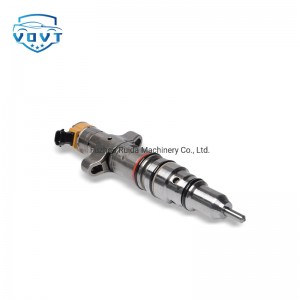New High Quality Diesel Injector 265-8106 266-4446 267-3360 267-3361 267-9710 For CAT C9
Products Description
| Reference. Codes | C9 |
| Application | C9 |
| MOQ | 4PCS |
| Certification | ISO9001 |
| Place of Origin | China |
| Packaging | Neutral packing |
| Quality Control | 100% tested before shipment |
| Lead time | 7~10 working days |
| Payment | T/T, L/C, Paypal, Western Union, MoneyGram or as your requirement |
Application differences of different types of injectors in new energy vehicle range-extended engines
According to the structure of the injection port
Hole-type injector:
Structural features: The injection port is in the shape of a circular hole, composed of parts such as a needle valve and a needle valve body, with many injection holes and small diameter.
Atomization effect: It can atomize the fuel into fine particles, forming a finer oil beam, with good atomization effect, which can fully mix the fuel and air and improve the combustion efficiency.
Applicable scenarios: It is suitable for direct injection combustion chambers with high requirements for spray quality. In the extended-range engine, if the engine combustion chamber is designed as a direct injection type, and the accuracy and atomization effect of fuel injection are required to be high, the hole-type injector is a better choice.
Axis needle injector:
Structural features: There is a slender needle valve at the injection port, and the tip of the needle valve forms a small annular gap with the injection port, and the shaft needle reciprocates in the spray hole.
Atomization effect: The diameter of the spray hole is large, the injection pressure is low, and the atomization effect is relatively poor, but the reciprocating motion of the shaft needle can remove carbon deposits in the spray hole, avoid blockage of the spray hole, and improve the reliability of work.
Applicable scenarios: Applicable to vortex chamber and pre-combustion chamber combustion chambers with low requirements for spray quality. If the combustion chamber structure of the range-extending engine is relatively simple and the self-cleaning ability of the injector is required to be high, the shaft needle injector is more suitable.
Plate valve injector:
Structural features: The valve plate opens under the fuel pressure, and the fuel is sprayed out from the gap between the valve plate and the valve seat.
Atomization effect: It has a faster response speed and higher injection accuracy, and can more accurately control the fuel injection amount and injection time.
Applicable scenarios: Applicable to engines with high requirements for injection control accuracy. In the range-extending engine, if the fuel injection needs to be accurately controlled to achieve better fuel economy and lower emissions, the plate valve injector may be adopted.
According to the number of spray holes
Single-hole injector:
Structural features: There is only one spray hole and the structure is simple.
Atomization effect: The fuel atomization effect is relatively poor, and the uniformity of the formed oil mist is insufficient.
Applicable scenarios: Applicable to engines with low requirements for fuel atomization and relatively simple structure. It may be used in some early or cost-controlled extended-range engines.
Dual-hole and multi-hole injectors:
Structural features: There are two or more injection holes.
Atomization effect: The fuel is sprayed from multiple holes, which can form a more uniform oil mist, so that the fuel and air are mixed more fully and the combustion efficiency is improved.
Applicable scenarios: Widely used in engines with high requirements for fuel atomization effect and combustion efficiency. In modern extended-range engines, in order to improve fuel economy and reduce emissions, dual-hole or multi-hole injectors are more common.
According to the resistance value of the electromagnetic coil
Low-resistance injector:
Structural features: The resistance value of the electromagnetic coil is low, and the magnetic field generated when energized is strong.
Response speed: It can quickly attract the needle valve to open, and the response speed is fast.
Applicable scenarios: Suitable for high-speed engines. In an extended-range engine, if the engine needs to quickly adjust the injection amount in a short time to adapt to different working conditions, such as high-speed driving or rapid acceleration, a low-resistance injector is more suitable.
High resistance fuel injector:
Structural features: The resistance of the electromagnetic coil is high, and the magnetic field generated when energized is weak.
Response speed: The needle valve opens slowly, but can more accurately control the amount of fuel injected.
Applicable scenarios: Suitable for engines that require precise control of fuel consumption. For extended-range engines, in some cases where fuel economy is required and operating conditions are relatively stable, high resistance fuel injectors can better achieve precise fuel injection control.

























